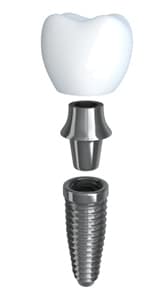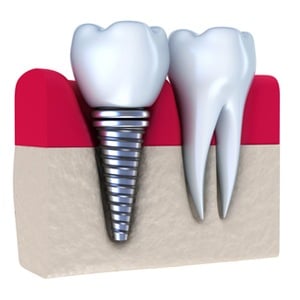Dental implants are the BMW or Mercedes-Benz of tooth restorations. An implant is an investment that is sturdy, reliable and lasts forever. They are the next best thing when you are no longer able to grow your own! Implants essentially replicate the root and tooth in your jaw.

Other Preventive Services
Dental implants are considered the most durable, functional, and natural solution for replacing missing teeth. While a bridge will affect adjacent teeth, dental implants involve introducing a titanium post into the jaw, providing a stable root over which a crown can be placed.
Using our Cone Beam Technology, we fabricate virtual surgical guides to plan and place implants precisely in your jaw.
Getting an Implant – The Initial Visit
The initial phase for an implant is gathering information by using a Tomography x-ray. This is used to assess the amount of bone available, which is necessary to provide stability for the surgical implant to be placed. If there is insufficient bone, then a graft may be warranted at that time.

Getting an Implant – The Surgical Phase
The surgical phase of the procedure begins with the administration of a local anesthetic to the area that the implant will be placed. Gum tissue is opened up in order to expose the jaw bone, and a hole is drilled into the bone to create space for the implant.
The implant is then placed by tapping or threading it into the hole, where it will fit snugly in place during the healing phase. The gum and soft tissue are then stitched closed over the implant. A dressing may be placed at that time, and healing can range from anywhere between 3 and 9 months. If wanted, a ‘flipper,’ or artificial tooth, can be made for you to wear so that you are still able to have a natural smile during the healing process.
Once the implant has fully osseo-integrated into the bone (which will be determined by an x-ray), the restorative phase can begin.
Getting an Implant – The Restorative Phase
This phase involves placing an ‘abutment’ on the implant, providing a base platform upon which to place the crown. The remainder of the treatment phase then mirrors that for placing a crown. An impression is taken of the implant in relation to adjacent and opposing teeth, and a temporary crown is made. The impression is submitted to a lab that will make the final crown.

Getting an Implant – The Final Visit
The permanent crown is cemented onto the implant. And, finally, the bite will be adjusted as needed for comfort.
The process for placing an implant from start to finish is longer than any other dental procedure, however, they are also going to outlast any other treatment option available when it comes to replacing missing teeth.
The results are permanent, leaving you with a natural-looking smile, and the confidence to eat the foods you love without worrying about sustaining damage to your reconstructed teeth. In addition, implants can help preserve facial structure, thus preventing the bone deterioration that can occur when teeth are missing.
If you have additional questions about dental implants and whether they’re a good solution for you, give us a call at (207) 782-5308 or contact us and we’ll be in touch!

Make an Appointment for Your Smile!




